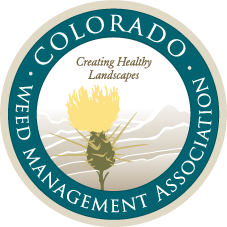Myrtle Spurge
Euphorbia myrsinites
Myrtle spurge is a List A noxious weed commonly found in the urban and foothill areas of Colorado. Initially sold as a xeriscape plant, this perennial of the spurge family, has escaped and naturalized in many areas including some remote and rugged areas.
Myrtle spurge shows up in early spring at lower elevations and begins to flower in March-April.
Grey-green leaves are fleshy, egg-shaped, and attach directly to the stem at their base. Stems are stout and trail along the ground. Leaves and stems contain a sticky, caustic sap that can cause severe rashes and blistering.
The inconspicuous flowers are surrounded by chartreuse bracts and develop at the ends of the stems. When the seeds ripen, they are expelled from their capsule and are covered in a sticky gel that adheres the seeds to surfaces and passing animals.
Landowners are encouraged to start looking for this plant in mid-February. It can be pulled as long as you remove the top few inches of the taproot. Herbicides also work well. The Colorado Department of Agriculture’s website has factsheets detailing control methods. https://www.colorado.gov/pacific/agconservation/noxious-weed-species#a
More info:
https://www.fs.usda.gov/Internet/FSE_DOCUMENTS/stelprdb5410110.pdf
https://cwma.org/weed-information/weed-list/myrtle-spurge/
What You Can Do
- Let your neighbors know if you see Myrtle spurge in your neighborhood.
- Organize a neighborhood weed-pull. To protect your skin from the caustic sap, wear long sleeves and rubber gloves if you are hand pulling.
- Make sure all parts of the plant are disposed of properly. Place in bags, securely close the tops, dispose of in the trash. Do not compost.
- Continue to monitor your sites. Myrtle spurge seeds may last for eight years in the soil. You will need to manage new plants before they spread.
Together we can make a difference!

